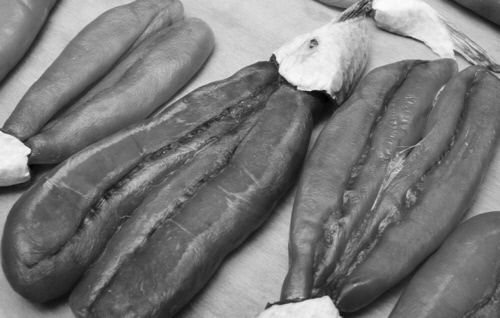Having arrived at Cabras, judging by the road signs we realised that we had parked close to the company of Mr. Pino Spanu. This firm produces salted, pressed and dried roe of mullets and tuna together with other smoked fish products besides sheep’s cheese mixed with roe. Actually, they extract the ovaries of female fish filled with mature eggs, and the finished product is called bottarga.
Being known since antiquity, the processing of roe into bottarga has been recorded in books at least since the Middle Ages. A certain Bartolomeo Platina wrote a book in about 1450 called “Honest pleasure and good health” where he is describing bottarga. A document from 1386 mentions a precious cargo of bottarga on board a Spanish galleon, which was attacked by pirates in the gulf of Oristano.
This paragraph has been translated from wikipedia: the origin of this product seems to be Phoenician, but the word is derived from the Arab word batārikh (بطارخ) which means salted fish eggs, but whose root may have meant “conserve in salt”. The Moors were famous in the Mediterranean countries for their refined culinary techniques, which were passed on to other Mediterranean peoples often with the Arab name attached. It was called butàriga in the Sardinian language in harmony with the Arab word. Maybe the word is derived from the Greek Byzantine word ᾠοτάριχον (ootàrichon) which signifies dried and salted fish (αυγοτάραχο (avgotàraho) in modern Greek) which is conserved in molten beeswax.
The company of Mr. Spanu has occupied itself with processing of local fish since its foundation in 2004, specialising in the last years in making bottarga from mullet, and having become experts in the field.
They also make bottarga from tuna, dried tuna meat, and various types of smoked fish like swordfish, salmon and eel.
When we entered the office of Mr. Spanu, we were struck by the intense smell of bottarga. Having presented ourselves, he showed us some products of the company like bottarga in baffe (that is, the real ovaries of female fish filled with mature eggs), grated bottarga (sold in bags and jars). He also explained the methods for drying and the various artisanal procedures for making bottarga, all of which have been passed down the generations and which today are used to produce bottarga from Cabras, a genuine product with a unique taste.
Bottarga is produced in many parts of the world, but the climate in Sardinia is ideal for the mullets who grow up in the brackish lakes near Cabras. Actually, the fish enter the lagoons from the sea and they find an ideal environment for grazing in the lagoons, mainly eating what resides on the lake bed.
All this united with the experience of the Sardinian artisans who are making bottarga, assures that the bottarga of Tharros fish is of prime quality, and among the most renowned in the area of Cabras.
Mullets above a certain size are captured near Oristano and eggs from female mullets are extracted and cleaned carefully. Then, the eggs are kept in brine for a time depending on the size of the ovary of the mullet, and it’s controlled by artisans who know how much is required in order to obtain an optimum product. Afterwards, the products are cleaned again, compressed and dried again. Finally, they are left hanging in darkness for some days such that the bottarga acquires the characteristic amber colour and it gives off an intense aroma distinguishing this product.
Bottarga is appreciated as a seasoning for spaghetti or just as a starter, cut in slivers and served with olive oil, even though it can be used in numerous recipes.
The visit at the company of Mr. Spanu has completed the whole cycle of bottarga: from fishing mullets, via processing to selling.

